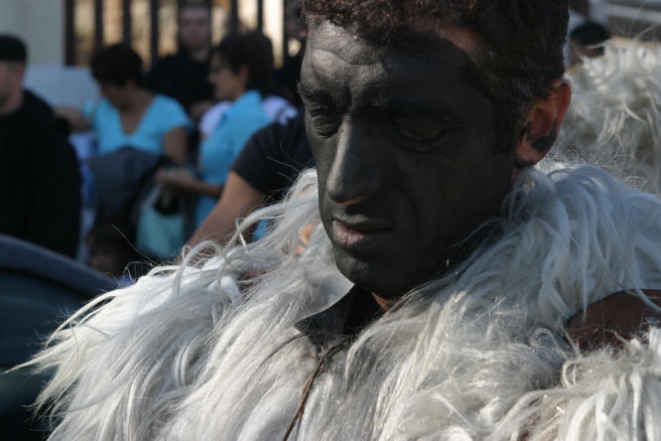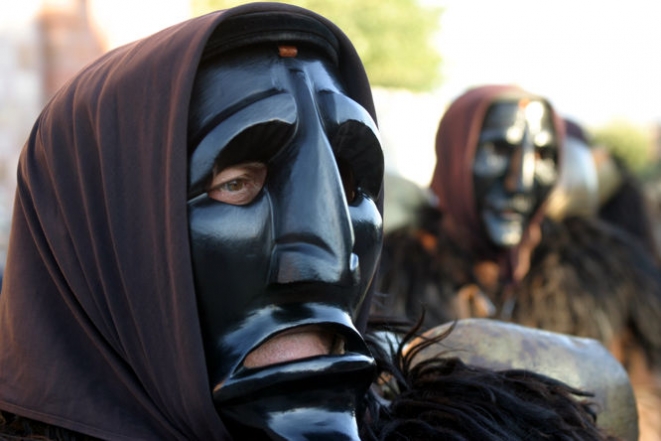A brief history of Carnival in Sardinia
From the Saturnalia to nowadays through the Renaissance
It is certainly not easy to investigate the origins of a festival such as the Carnival, since no one was willing or able to keep historical records.
As much as the etymological derivation is discussed, the term "Carnival" seems to probably come from the Latin "carnem levare" ("eliminate the meat"), which once indicated the banquet that was held during the last day of Carnival (Mardi Gras), immediately before the period of abstinence and fasting of Lent.
The same word, therefore, emphasizes the rebellious and subversive festivity.
In fact the short period of the Carnival can be defined as a "period of chaos," of the world upside down, in which "the fool can become king and vice-versa", because any kind of hierarchy falls down. Through the masking one can get out of the daily routine, deny and discard themselves from their roles and social obligations, so they can become anyone else.
The tensions and the problems of life are temporarily forgotten, for to be later restored at the end of the festival. From a historical and religious point of view, the Carnival represented, therefore, a symbolic renewal period during which chaos replaced the established order, which, however, once exhausted the festive period, reemerged new or renewed and guaranteed for one valid cycle until the beginning of the next Carnival.

The Carnival has its roots in ancient pagan rituals, in the historical period prior to Christianity. It was a festivity with strong symbolic values related to the agro-pastoral world; with a special ceremony in mask, in fact, the end of winter and the arrival of spring were greeted, to gain wealth and fertility of the land with abundant harvest.
For the Romans the first expression of the Carnival were the Saturnalia, the festivities in honor of Saturn, Italic god of agriculture. The Saturnalia began on December 17th and lasted for seven days during which everything was possible (eating, drinking, joking), but in particular, the exchange of social roles was granted and slaves could be considered temporarily free men, and they could behave as such.
With the advent of Christianity and the consequent abolition of all pagan festivities, the Carnival continued to be celebrated; it lost its magic and ritual content and it was simply a form of popular entertainment. The beginning was variously set on January 1st, January 17th (St. Anthony the Abbot), February 2nd (Candlemas).
During the Medieval period, the festivity of the Carnival was the form of a second life for the people who came, even if for a brief moment, in the realm of freedom and social equality. Truth to be told, behaviors were in a sense constrictive, because it was mandatory to laugh and trigger any appetite, from food to the sex. In unofficial folk festivities, there was a particular relevance for the reversal of values (the material in the place of the spiritual, from down to high, the belly and sex instead of the head, the comedian instead of the serious, the people instead of the powerful).
Besides the Carnival itself, with all its actions and complicated processions that used to keep for days the squares and streets occupied, The "Feast of Fools" (feast stultorum) and the "feast of the ass" were also celebrated; and there also was a special "Easter laughter" (risus paschalis), consecrated by tradition. Moreover, almost all the religious festivities had their comic aspect, public and popular, also consecrated by tradition.
This was the case, for example, of the "temple festivities", usually accompanied by fairs, with their rich and diverse array of public entertainment (there were performing giants, dwarfs, monsters, beasts "wise"). In the late Middle Ages, disguising during the cities' carnivals spread all around. The disguise allowed so the exchange of roles, the making fun of social hierarchies, the caricature of the vices and bad habits.
Those same masks have since become the symbol of the city and of human weaknesses. In the Renaissance, the Carnival festivities were also introduced in the European courts and assumed more refined forms, related to the theater, dance and music. In Italy the Carnival reached its peak in the Sixteenth Century, during the Florence of Lorenzo de' Medici, with long parades of floats, gaudy costumes, dances and carnival songs (songs to dance to), among which the most famous was "The Triumph of Bacchus and Ariadne", written by Lorenzo de Medici himself.

The journey into the rich and complex history of the uses and customs of Sardinia takes us very far in time, and our Carnival also has similarities with the Roman Saturnalia or the oldest agro-pastoral cults.
In our Island we can attend to different manifestations of Carnivals, equally fascinating and full of meaning. In Bosa, Ottana, Orani and Mamoiada the typical Carnival of Barbagia is sad, dark and, in some respects, "tragic and grotesque" with its ancestral anthropomorphic and zoomorphic masks, the garments of goat skins, woolen and bells that evoke mysterious rites, propitiatory dances and a close relationship, almost visceral, between man and animal. The Carnival in Barbagia is deeply tied to the economic and social system of the agro-pastoral civilization of which is its mirror.
The life of the shepherd, isolated from the community for months with his flock has determined the true essence of the Carnival events: exorcising the risk that the individual could lose their "humanity" transforming themselves definitively into a beast. In the land of Oristano the equestrian shows, rides and poles, are generally the focus of the party and are aimed at propitiate the harvest of the year or to exhibit the values of courage and dexterity of the horsemen "Sa Carrela e'nanti" in Santulussurgiu", the Sartiglia of Oristano. However, in other places on the Island there are traditional and irreverent parades of floats and masks of the allegorical Carnival, its end decreed by the death of the King of the Carnival (King Giorgio in Tempio, Cancioffali in Cagliari, Gioldzi in Bosa and in north Sardinia, Maimone in Ogliastra).
The party often keeps the memory of archaic rituals of the end of the year: the latter represented by the puppet rag that is on trial, condemned to the stake and weept at with a ridiculous dirge.
During 16th and 17th January, in many small towns of Sardinia Saint Anthony is celebrated, whose night it is illuminated by the traditional fireworks. As of the day before, and the day of the festival, all people, young and old, take part in the collection of the firewood, which is carried in the main square of the small town to form a huge pile.
For his suggestion, the ritual of collecting firewood that takes place in Ottana should be noted: the whole small town is involved and truck full of loads of wood are accompanied by different cars, which at the sound of the cars' horns guide the particular procession to Piazza San Nicola, where the bonfire of the night will blaze.
In the church we celebrate the Holy Mass in honor of St. Anthony Abbot, after which, followed by the priest and by a large crowd of faithful people, the statue of the saint is carried through the procession into the square, where three circles will be made around the fire to be finally brought to church. Right in that moment, the religious aspect reaches an end, and the pagan festivity begins with the first exit of the masks (sos Boes, sos Merdules, sa Filonzana). Later into the night, dancing and singing are done around the bonfire.